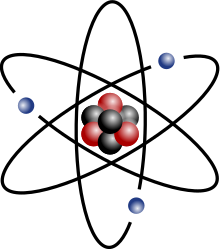
Back Atoommassa Afrikaans Peso atomico AN كتلة ذرية Arabic كتلة درية ARY Masa atómica AST Atom kütləsi Azerbaijani Атом массаһы Bashkir Атомна маса Bulgarian পারমাণবিক ভর Bengali/Bangla Mas atomek Breton
This article needs to be updated. The reason given is: it needs to reflect the 2019 redefinition of the SI base units, which came into effect on 20 May 2019. (January 2020) |
| Atomic mass | |
|---|---|
 Stylized lithium-7 atom: 3 protons, 4 neutrons, and 3 electrons (total electrons are ~1⁄4300th of the mass of the nucleus). It has a mass of 7.016 Da. Rare lithium-6 (mass of 6.015 Da) has only 3 neutrons, reducing the atomic weight (average) of lithium to 6.941. | |
Common symbols | ma, m |
| SI unit | kilogram (kg) |
Other units | dalton (Da) |
| Intensive? | yes |
Behaviour under coord transformation | scalar |
The atomic mass (ma or m) is the mass of an atom. Although the SI unit of mass is the kilogram (symbol: kg), atomic mass is often expressed in the non-SI unit dalton (symbol: Da) – equivalently, unified atomic mass unit (u). 1 Da is defined as 1⁄12 of the mass of a free carbon-12 atom at rest in its ground state.[1] The protons and neutrons of the nucleus account for nearly all of the total mass of atoms, with the electrons and nuclear binding energy making minor contributions.[2] Thus, the numeric value of the atomic mass when expressed in daltons has nearly the same value as the mass number. Conversion between mass in kilograms and mass in daltons can be done using the atomic mass constant .
The formula used for conversion is:[3][4]
where is the molar mass constant, is the Avogadro constant,[5] and is the experimentally determined molar mass of carbon-12.[6]
The relative isotopic mass (see section below) can be obtained by dividing the atomic mass ma of an isotope by the atomic mass constant mu yielding a dimensionless value. Thus, the atomic mass of a carbon-12 atom is 12 Da by definition, but the relative isotopic mass of a carbon-12 atom is simply 12. The sum of relative isotopic masses of all atoms in a molecule is the relative molecular mass.
The atomic mass of an isotope and the relative isotopic mass refers to a certain specific isotope of an element. Because substances are usually not isotopically pure, it is convenient to use the elemental atomic mass which is the average (mean) atomic mass of an element, weighted by the abundance of the isotopes. The dimensionless (standard) atomic weight is the weighted mean relative isotopic mass of a (typical naturally occurring) mixture of isotopes.
The atomic mass of atoms, ions, or atomic nuclei is slightly less than the sum of the masses of their constituent protons, neutrons, and electrons, due to binding energy mass loss (per E = mc2).
- ^ IUPAC, Compendium of Chemical Terminology, 2nd ed. (the "Gold Book") (1997). Online corrected version: (2006–) "atomic mass". doi:10.1351/goldbook.A00496
- ^ "DOE Explains...Nuclei". Energy.gov. Retrieved 2023-04-13.
- ^ The International System of Units (SI). v1.06 (9 ed.). Paris: Bureau International des Poids et Mesures. 2019. ISBN 978-92-822-2272-0.
- ^ Peter J. Mohr, Barry N. Taylor (May 20, 2019). "NIST Standard Reference Database 121. Fundamental Physical Constants. atomic mass constant". The NIST reference on constants, Units and Uncertainty. National Institute of Standards and Technology. Retrieved December 10, 2019.
- ^ "Avogadro constant". The NIST Reference on Constants, Units, and Uncertainty. May 2019. Archived from the original on 2000-10-25. Retrieved 24 June 2021.
- ^ "Molar mass of carbon-12". The NIST Reference on Constants, Units, and Uncertainty. May 2019. Archived from the original on 2000-12-06. Retrieved 24 June 2021.
© MMXXIII Rich X Search. We shall prevail. All rights reserved. Rich X Search




